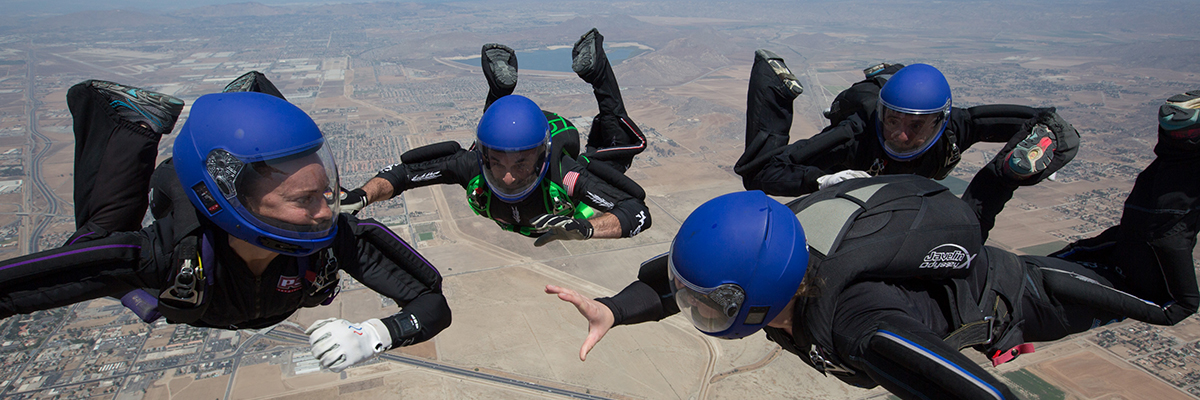Stop Brainlocking! Big fat guide to reducing mental errors.
Monday, May 3, 2021

Brainlock is a great word. It is self-explanatory and relatable. The instant you tell someone about that word, they know what you mean. This error happens to everyone and makes new and old skydiver cringe alike.
This guide will talk about what brain locking is, many strategies at reducing them, from basic to advanced.
Definition
Brainlocking is a mental error for skydivers resulting in not knowing where to go in a formation. Not knowing where to go or moving in the wrong direction defines it. Other categories of mental errors like miskeys or looking at grips fall outside of this article’s scope.
I’m going to list five significant contributors to brain locks. There are other types, but this covers most of them.
Types
Overload
This sort of brainlock is more common for newer jumpers but can happen to anyone feeling too much anxiety or stress. Just like time slows down when you are focused and calm, it can speed up when a person is overexcited. Instead of vision opening up and things becoming clear, it narrows to a tunnel, and memory gets fuzzy.
A typical example here is exit blindness. If you find yourself struggling to stay aware or remember lining up at the door, over-arousal may be to blame.
Calm and experience can help reduce this.
Forgetting
This category is merely forgetting the next point. No trigger contributes besides failing to recall. Not enough prep, not enough visualization, or just being a human can mean you can’t remember a formation when you want. It can also result in mixing up the sequence. And sometimes the whole dive vanishes from your head.
The cure for this is familiarity, prep, and visualization.
Distraction
For experienced jumpers, this is a common brain lock category—this brain lock happens when you are not thinking about what you are doing. While your mind strays, you lose the thread of where you are supposed to go.
Many things can distract you from a dive sequence. It can also come from other worries in your life or emotion like competition, stress, or fear.
Learning to focus or stay in the moment is the best cure for this category.
Lack of anticipation
This brain lock is more subtle than the others. Sometimes it can even escape without notice in a debrief. As you get good at formation skydiving, you must be thinking ahead to initiate movement instantly. Hesitation, as opposed to complete bewilderment, is also a brain lock because it stalls the dive.
Familiarity and visualization techniques can reduce this type of error.
Debriefing
Debriefing is excellent when it is on the ground! In the middle of a skydive, it can cause brainlocks as your mind starts thinking about earlier parts of the jump. Wanting to improve as the jump goes on is natural and positive when that is the jump’s goal. However, it is important to silence your inner coach and focus on the now in competition or performance-oriented skydives. Being in the moment keeps your busy brain honed in on executing each point correctly.
Fix this by learning to focus on what is happening right now.
Basic Fixes
Familiarity
If you are unfamiliar with the formations, it will be more challenging to remember them. If you have many mental models to build and reinforce, it is understandable that it takes longer to learn a sequence. This extra learning makes you more likely to forget a part of it.
If you are starting formation skydiving, you don’t know an open accordion from a sidebody. As you progress to 4-way, 8-way or big way, the formations are more complex but just as foreign. When you climb up to higher division, you will learn slot switchers. No matter where you are in that chain, the more you do see and study the moves you need to do, the easier it becomes.
Learn
Learning the formations and the components is a huge step. If you are beginning, learn the two-way components first. Add some of the basic 4way shapes and perhaps the competition 4way shapes. Knowing the elements will help you recognize and make sense of larger formations.
Visualize
Visualizing is mentally rehearsing or imagining something. Competitors develop this skill significantly to remember and practice their sequence even before getting out of a plane.
A powerful tool, you can use it to rack up your practice time without hitting the air. To get started on the ground, craft a skydive, and imagine yourself completing the sequence as a skydive or tunnel flight. Do this on the ground, in the plane, or at home with hypothetical jumps between skydiving weekends.

Practice
Nothing beats plain old practice! You can familiarize yourself with formation by doing them a lot on creepers or in the air. If you intertwine your training with learning and visualizing, you will find yourself becoming comfortable with a variety of formations quickly. Flying is fun, and it allows you to see the real distances, angles, and images for different combinations. Practice informs your visualization efforts and makes learning new formations easier. It is a virtuous circle!
Physically Ready
If you don’t take care of your body, your brain will spend time and energy, reminding you that there is an issue. Make sure that you act like an athlete – eat, sleep, and hydrate! Avoid partying hard the night before, so you don’t spend energy thinking about how awful you feel on that first load!
Bonus tip: Give it a name
Not every crazy formation has an official name, especially non-competition odd-ways. But don’t let that stop you from calling it something. You can keep it simple (Point 1, 2, 3), based on other formations (star thingy, sidebody doodad, donuty whatchamacallit, meeker flake), or make something wild (elephant ear, propellor, sue). Having something to mentally call each point as you dirt dive helps trigger the sequence and can be tremendously useful when doing creative jumps.
Medium Fixes
Focus on recovery
The bad news is that even professionals brain lock. I, gasp, have even brain locked at a big meet. As long as we are human, we can’t be perfect. Brain locks are.
In addition to reduction, we can focus on recovery. A small glitch can be almost imperceptible if you teach yourself to recover quickly and get on the with the jump. Don’t make a little error a big one by shutting down or not recovering well.
Reset and resume
An excellent recovery involves a reset and resume. If you are the one brain locking, your first step is to stay calm. Then figure out where you should be. Once you know that, let it slide and go back to having a rocking skydive. The more swiftly you can do that cycle, the less impact your brainlock will have.
Helping brainlocking teammates
If you are not the one brain locking, the first thing you should do is move to your spot calmly and wait. By being in the right place and patiently waiting, the brainlocker has the best chance to see what is happening. The team has the best chance of isolating the error to just that one little mistake, instead of going forward.
A key element here is calm. The brainlocking person will undoubtedly experience that heart-pounding associated with this type of mistake. If you stay calm, it will help them be relaxed, which will improve their ability to get back on track.
Now let’s talk about pointing. There is a time and correct way to direct your teammate to their slot by gesturing. But that time is not immediately, and that method is not frantic.
When someone has lost the plot, just knowing where to go right now is only part of the issue. The confused teammate needs to calm down and resume the flow of the jump. When teams lose their minds and start gesticulating wildly, it doesn’t exude a serene mind.
If someone doesn’t know where to go, be calm, and be in your slot. If matters continue, point gently like the Dali lama would guide someone. Be calm. Please be calm.
Recognize mode of the dive
If you are training not every jump is performance-oriented. You might do drills in 4way, for instance, or not pick up grips in a big way scenario. These jumps draw your focus on a technical aspect or specific goal. Think about what you are doing instead of trusting and performing the jump. (Training should consist of plenty of competition mindset jumps as well as core training jumps)
Brain locks are not desirable in this scenario, but they aren’t the same level of concern as in a competition-style jump. If you concentrate on cat piece improvement, you might let the other point accidentally slip. If it happens a lot during drill dives, consider dropping a point, reducing the number of fixes, or breaking down the goal into even smaller steps.
Treat it like a physical error
People get more upset by a brain lock than they will for a physical error. If I have a student that struggles with turning in place, they shrug and do some tunnel time to fix the problem. If I have a student who brainlocks, there is often denial, shame, and a sense that it lacks effort. The only plan is to ‘try harder.’
This stigma makes matters worse and doesn’t outline any improvement. Just like any physical skill, you can practice and train mental skills. You can reduce your brain locks and increase your focus by breaking down the problem and training.
Prep
Make a good prep plan, and stick to it. Doing the same thing every time is critical. If your prep isn’t working for you, you can adapt part of it if you have a consistent plan. If you do ‘whatever’ every time, there is no accurate way to determine if your alterations have a positive effect.
If your prep isn’t working, maybe adding a phase, changing when you do it, or lengthening it could help.
Plane routine/Visualizing
Just like your ground prep, your visualizing routine on the plane should be consistent. Plane prep gets overlooked since it isn’t visible. Your mental prep in the aircraft should be deliberate and consistent. Write down what you intend to think about/visualize every jump.
If you are consistent about this, you can alter and test the results. Changing your mental rehearsal’s perspective, speed, frequency, timing, or duration can improve your focus and decrease your brainlocking.
Meditation
Meditation isn’t about just sitting in a corner and staring at a blank wall. With small amounts of the right training, you can learn to quiet your head and improve your focus. I strongly recommend Headspace if you are new and curious; it is a free guided mediation app with great instructions.
Advanced Fixes
The wrong way to keep score of brain locks
Some teams keep a tally of their daily brain locks along with their daily goals. It is a common practice that I feel makes matters worse.
Brainlocking is no different than other physical mistakes. Why especially isolate these? Logging is a powerful tool and can be very useful. But these tallies aren’t detailed by type of brain lock, nor are they associated with a specific training goal. They are often just a means of shaming teammates.
In the infrequent circumstance that you have a teammate who is not putting in the homework or effort, I suppose this could help. But that case is rare; most people are genuinely trying. Besides, I’d try for inspiration before shaming.
If it were part of a specific daily training goal, a tally could work. However, I’d expect to see other tallies on the board on different camps – turning in place, fall rate control, or closed blocks, for example. I don’t see other things measured the same way.
The ever-present brain lock tally encourages denial, defensiveness, and hiding. It separates this type of error out in a way that can produce more anxiety and worsens the problem.
Bonus Tip for 4-way/8-way: Menmoics and Alphabet soup
On a long day doing lots of different jumps, sometimes the sequences start to bleed together for even me. The worst for me personally is all random jumps – five-point series represented by letters. Despite 20 years of familiarity, if I do more than a handful of these types of skydives in a day, it becomes alphabet soup in my head. I’ll cringe on the plane as I have to reconfirm the sequence with my teammates to resume my visualizing with confidence. Other times I’ll imagine the whole jump with the wrong point with complete certainty.
But I have a fix! When I have an alphabet soup training scenario, I make up a silly mnemonic sentence. HFGPB becomes Hope Frikken Gets Plenty Bacon or something equally goofy. It is easy to remember and check my visualizing against it to avoid muddling.
Recognize, Regroup, Refocus
Start a log
If the general strategies aren’t enough and you want to train yourself to reduce your brainlock you should start logging your incidents. You can begin a separate log, put them in your notes, or add them to your logbook entry. Note this isn’t to just count them, it will be to break down the most common causes.
Recognize you are doing it
I labeled five categories of brain lock above, including overloading, forgetting, distraction, debriefing, and anticipation. However, the brain lock manifests, there is an identifiable trigger that precedes it. If you fail to remember the jump, maybe you realize you forgot to visualize. If you have an anticipation brain lock, perhaps you aren’t vigilant enough with homework.
After you have tracked your brainlocks and what you were thinking right beforehand, a picture of your most common issues should emerge. Identify the types of thoughts that occur right before problems.
This list will help you start recognizing when you are not mentally on task. Catching yourself in the act will allow you to guide your attention back to the jump.
Regroup
After you have listed out the types of things that trigger your brainlocks, create a phrase or word that will help stop you heading further down that mental path. It can be a short sentence like “This is not important right now” on the ground or in the plane. I recommend a single word cue in the air – since you need to get back into quickly. “Breath,” “Relax,” or “Focus” are excellent examples.
Refocus
The last step with your log is to decide what you should be thinking about instead. Again, in the sky, this should be short – “Look,” “Calm,” or “Next Point” are great examples.
Implementation
Now that you have a log and a plan to get yourself back on track put it into action! Spend some time visualizing your Recognize/Regroup/Refocus plan. Then skydive! Try to catch a precursor to a brainlock, regroup yourself, and then refocus on the task at hand.
Your logbook should now include feedback about how your strategy worked. You can adjust ones that don’t work, and add new triggers if they pop up.
Examples
| Recognize | Regroup | Refocus |
| People talking too much on the plane | Their actions do not matter for what I want to do | Get back to visualizing and my plane prep process |
| I’m stressed at work | I can’t fix my problem on the way to altitude | Breath and meditate |
| Kicked in the head | Breathe | Next Point |
| That block isn’t closing | Be present | Look |
No matter if you are starting FS and overwhelmed or a serious competitor, improving your focus and reducing your brainlocks will improve your skydivers. Trying some or all of these techniques will help you feel more focused and in control, which will improve your jumps and help you enjoy them more!




